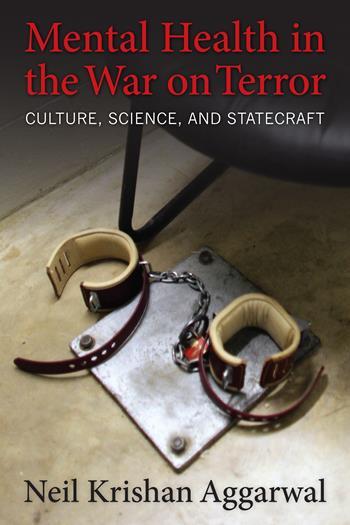Discouraging North American and European Citizens from Foreign Jihad
This week our featured book is Mental Health in the War on Terror, by Neil Krishan Aggarwal. Throughout the week, we will be posting content from and about the book and it’s author. In today’s guest post, Aggarwal discusses a recent New York Times article on efforts to keep Western citizens from “traveling to fight in war zones in Muslim countries,” and how the War on Terror has been and is being shaped by sometimes troubling stereotypes.
Don’t forget to enter our book giveaway for Mental Health in the War on Terror!
Discouraging North American and European Citizens from Foreign Jihad
By Neil Krishan Aggarwal
A New York Times article dated January 13, 2015 and titled “West Struggles against Flow to War Zones” describes North American and European officials struggling to “stem the flow of their citizens traveling to fight in war zones in Muslim countries.” The article comes after last week’s tragic attacks in France and reflects major themes from my book Mental Health in the War on Terror: Culture, Science, and Statecraft. In my book, I analyze questionable claims of Orientalist stereotypical scholarship and de-radicalization programs, some of which appear in this article. By scrutinizing this article, I hope to show how such claims recur in an influential newspaper and shape public discussions of the War on Terror. Only by inspecting such claims one at a time can we discern how the War on Terror has permeated popular culture.
1. The “West/Rest” fallacy. The authors begin: “For more than a decade, Western governments have struggled to stem the flow of their citizens traveling to fight in war zones in Muslim countries.” This assertion implies a rigid division among Muslims and non-Muslims. Where does the West begin and end? What is the standard for “Muslim countries”? Is a Muslim country defined on the basis of political system (Saudi Arabia), population (Indonesia), or Orientalist notions of the Middle East? Are we not comparing apples and oranges by contrasting entities based on geography (“Western”) and religion (“Muslim”)?
The article seems to assume that “Muslim countries” means the Middle East, since the next paragraph describes “one man who travel[ed] to Yemen” and “about 1,000 militant recruits joining the fight in Syria and Iraq each month, according to recent United States government figures.” We could also describe these countries simply as divided by civil war. The description “Muslim” reinforces the connection between violence and Islam. It also gives fodder to militant groups such as the Taliban (as I show in my new book also to be published by Columbia University Press) that charge American officials and journalists with propagating a war against Muslims and Islam despite their disavowals.
2. The War on Terror as a state of exception requiring new laws. The authors write: “New or amended counterterrorism laws have been passed in countries like Albania, Australia, Bosnia, France, Kosovo, Macedonia and Serbia, making it illegal to travel to fight in a foreign conflict, like the ones in Yemen, Syria and Iraq. Malaysia and Saudi Arabia have issued bans prohibiting their citizens from joining the Islamic State. Arrests of people suspected of being militants have increased in Austria and Morocco, and foreign fighters have been prosecuted recently in Germany and the Netherlands.”
I doubt that people committed to traveling to war-torn areas for militancy will reverse course once they realize that this is illegal. From a cultural perspective, what is interesting is how governments construct new laws (like those mentioned above or the American Military Commissions Acts), institutions (Abu Ghraib, Guantanamo), and categories of people (“enemy combatant,” “foreign fighter”) in the War on Terror. Are extant law enforcement mechanisms with public oversight so unsuited for counterterrorism? CIA torture techniques, Guantanamo, and similar counterterrorism enterprises outside of public view concern me, especially when we risk detaining innocent people (“suspected” rather than “proven”) without due process.
3. The War on Terror’s global reach. Our authors continue: “The United States seized on the issue last September and successfully pushed through a legally binding resolution at the United Nations Security Council that would compel all countries to take steps to ‘prevent and suppress’ the flow of their citizens to groups considered to be terrorist organizations.”
All countries must now be involved in this new regime of global security. Do we really need new laws when, by definition, terrorist organizations are banned in many countries? What do we do in situations when UN member countries disagree if a militant organization is truly “terrorist” (i.e. Hebollah as a terrorist organization for the United States but a legitimate political party in Lebanon)? How would the success and failure of such a legal program be measured?
4. Terrorism as a problem of Islam, not political violence. The authors discuss varying motivations inspiring foreign fighters: “What is different today, terrorism experts said, is the scale of the flow and the various reasons young Muslim men, and increasingly women and families, are flocking to Syria. Young men in Bosnia and Kosovo are traveling to Syria for financial gain, including recruiting bonuses some groups offer, counterterrorism specialists say. Others from the Middle East and North Africa are attracted more by the ideology and the Islamic State’s self-declared status as a caliphate. Counterterrorism specialists have seen criminal gang members from as far as Sweden seeking adventure and violence in the fight.”
By describing these individuals as “young Muslim men,” the authors strengthen the association between Islam and violence, especially in invoking the “caliphate.” I don’t doubt that some are drawn by the prospect of Paradise through a militant interpretation of religion. However, the authors note the role of socioeconomic deprivation (“traveling to Syria for financial gain”) and criminality (“gang members”), indicating many possible inspirations. As I show in the book, de-radicalization programs seek to either change militant Islamic beliefs or target violent thoughts and behaviors. And militants can conceal violent beliefs from state officials, as suggested by recidivism rates from Guantanamo and Saudi Arabia.
Instead, we need better psychological models to answer the following questions: (1) How and why do certain individuals buy into group narratives of violence? (2) When do violent thoughts lead to violent actions? (3) What could have prevented individuals from violent actions and violent thoughts? (4) What was their journey and life like? (5) Why did they come back? We learn: “Senior American authorities have identified ‘several dozen’ Americans who have linked up with jihadist groups there [Syria] like the Islamic State or the Nusra Front and then returned to the United States.” It is high time that we interview them to understand the draw of militancy. Such interviews can possibly elucidate common risk factors and psychological mechanisms that we need to target in prevention and rehabilitation programs. Otherwise, we will continue developing new laws and counterterrorism tactics without any specific aims.




